Root Canal Therapy
What is a root canal?
A root canal is one of the most common dental procedures performed, well over 14 million every year.
At the center of your tooth is pulp. Pulp is a collection of blood vessels that helps to build the surrounding tooth. Infection of the pulp can be caused by trauma to the tooth, deep decay, cracks and chips, or repeated dental procedures. Symptoms of the infection can be identified as visible injury or swelling of the tooth, sensitivity to temperature or pain in the tooth and gums.
If you experience any of these symptoms, your dentist will most likely recommend non-surgical treatment to eliminate the diseased pulp. This injured pulp is removed and the root canal system is thoroughly cleaned and sealed. This therapy usually involves local anesthesia and may be completed in one or more visits depending on the treatment required. Success for this type of treatment occurs in about 95% of cases. If your tooth is not amenable to endodontic treatment or the chance of success is unfavorable, you will be informed at the time of consultation or when a complication becomes evident during or after treatment. We use local anesthesia to eliminate discomfort. In addition, we will provide nitrous oxide analgesia if indicated. You will be able to drive home after your treatment, and in most cases you will be comfortable returning to your normal routine.
What happens after treatment?
When your root canal therapy has been completed, a record of your treatment will be sent to your restorative dentist. You should contact their office for a follow-up restoration within a few weeks of completion at our office. Your restorative dentist will decide on what type of restoration is necessary to protect your tooth. It is rare for endodontic patients to experience complications after routine endodontic treatment or microsurgery. If a problem persists, please do not hesitate to call our office.
Apicoectomy - An Overview of Endodontic Surgery
Why would I need Endodontic Surgery?
Generally, a root canal is all that is needed to save the tooth. Occasionally, your endodontist will recommend surgery. Endodontic surgery can be used to locate fractures or hidden canals that do not appear on x-rays but still manifest pain in the tooth. Damaged root surfaces or the surrounding bone may also be treated with this procedure. The most common surgery used to save damaged teeth is an apicoectomy or root-end resection.
What is an Apicoectomy?
An incision is made in the gum tissue to expose the bone and surrounding inflamed tissue. The damaged tissue is removed along with the end of the root tip. A root-end filling is placed to prevent reinfection of the root and the gum is sutured. The bone naturally heals around the root over a period of months restoring full function.
Following the procedure, there may be some discomfort or slight swelling while the incision heals. This is normal for any surgical procedure. To alleviate any discomfort, an appropriate pain medication will be recommended. If you have pain that does not respond to medication, please call our office.
Endodontic Treatment
With the appropriate care, your teeth that have had endodontic treatment should last as long as other natural teeth. Yet, a tooth that has received treatment may fail to heal or pain may continue to exist. Sometimes, the pain may occur months or years after treatment. If so, Endodontic Retreatment may be needed.
In some cases, new problems can influence a tooth that was successfully treated:
- New decay can expose a root canal filling material, causing infection.
- A cracked or loose filling or crown can expose the tooth to new infection.
Once treatment has been selected as a solution to your problem, the doctors will reopen your tooth to gain access to the root canal filling material. This restorative material will be removed to enable access to the root canal. The doctors will refill your canals and carefully examine the inside of the problematic tooth. Once cleaned, the doctors will fill and seal the canals and place a temporary filling in the tooth.
At this point, you will need to return to your dentist as soon as possible in order to have a new crown or restoration placed on the tooth to restore full functionality.
After Completion of Endodontic Treatment
A follow-up restoration must be placed to protect your tooth against fracture and decay. Please telephone your restorative dentist for an appointment. A complete report of treatment will be sent to your restorative dentist. Included in your treatment is a follow-up examination to evaluate the progress of healing.

As part of our commitment to provide you and your family with the best possible oral healthcare, we have invested in a state-of-the-art 3D dental imaging system from Planmeca. This piece of dental technology not only provides a wealth of information, but it does so with the lowest radiation possible, and that’s important to us. In fact, we are a Planmeca Ultra Low Dose™ certified practice.
Our 3D imaging system allows us to see your anatomy in three-dimensional detail. It can be enlarged, rotated, and divided in any direction, thus revealing critical information not always seen in 2D images. Having this kind of technology at our fingertips allows us to better diagnose and treat a wide variety of dental related issues with accuracy and predictability.
If you’d like more information about our Planmeca 3D imaging system, please ask one of our staff members. We’re excited about this technology and continuing commitement to provide you with excellent dentistry and patient care.
